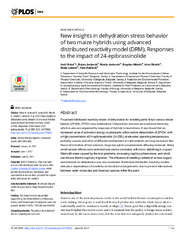New insights in dehydration stress behavior of two maize hybrids using advanced distributed reactivity model (DRM). Responses to the impact of 24-epibrassinolide
2017
Аутори
Waisi, HadiJanković, Bojan

Janković, Marija
Nikolić, Bogdan

Dimkić, Ivica

Lalević, Blažo
Raičević, Vera
Чланак у часопису (Објављена верзија)
Метаподаци
Приказ свих података о документуАпстракт
Proposed distributed reactivity model of dehydration for seedling parts of two various maize hybrids (ZP434, ZP704) was established. Dehydration stresses were induced thermally, which is also accompanied by response of hybrids to heat stress. It was found that an increased value of activation energy counterparts within radicle dehydration of ZP434, with a high concentration of 24-epibrassinolide (24-EBL) at elevated operating temperatures, probably causes activation of diffusion mechanisms in cutin network and may increases likelihood of formation of free volumes, large enough to accommodate diffusing molecule. Many small random effects were detected and can be correlated with micro-disturbing in a space filled with water caused by thermal gradients, increasing capillary phenomena, and which can induce thermo-capillary migration. The influence of seedling content of various sugars and minerals on dehydration was also examined. Estimated distributed reactivity models indicate a dependen...ce of reactivity on structural arrangements, due to present interactions between water molecules and chemical species within the plant.
Извор:
PlOS One, 2017, 12, 6Издавач:
- Public Library of Science (PLoS)
Финансирање / пројекти:
- Динамика нелинеарних физичкохемијских и биохемијских система са моделирањем и предвиђањем њихових понашања под неравнотежним условима (RS-MESTD-Basic Research (BR or ON)-172015)
- Биодиверзитет као потенцијал у екоремедијационим технологијама оштећених екосистема (RS-MESTD-Technological Development (TD or TR)-31080)
- Нове технологије за мониторинг и заштиту животног окружења од штетних хемијских супстанци и радијационог оптерећења (RS-MESTD-Integrated and Interdisciplinary Research (IIR or III)-43009)
DOI: 10.1371/journal.pone.0179650
ISSN: 1932-6203
PubMed: 28644899
WoS: 000404145100029
Scopus: 2-s2.0-85021290878
Институција/група
IZBISTY - JOUR AU - Waisi, Hadi AU - Janković, Bojan AU - Janković, Marija AU - Nikolić, Bogdan AU - Dimkić, Ivica AU - Lalević, Blažo AU - Raičević, Vera PY - 2017 UR - https://plantarum.izbis.bg.ac.rs/handle/123456789/485 AB - Proposed distributed reactivity model of dehydration for seedling parts of two various maize hybrids (ZP434, ZP704) was established. Dehydration stresses were induced thermally, which is also accompanied by response of hybrids to heat stress. It was found that an increased value of activation energy counterparts within radicle dehydration of ZP434, with a high concentration of 24-epibrassinolide (24-EBL) at elevated operating temperatures, probably causes activation of diffusion mechanisms in cutin network and may increases likelihood of formation of free volumes, large enough to accommodate diffusing molecule. Many small random effects were detected and can be correlated with micro-disturbing in a space filled with water caused by thermal gradients, increasing capillary phenomena, and which can induce thermo-capillary migration. The influence of seedling content of various sugars and minerals on dehydration was also examined. Estimated distributed reactivity models indicate a dependence of reactivity on structural arrangements, due to present interactions between water molecules and chemical species within the plant. PB - Public Library of Science (PLoS) T2 - PlOS One T1 - New insights in dehydration stress behavior of two maize hybrids using advanced distributed reactivity model (DRM). Responses to the impact of 24-epibrassinolide IS - 6 VL - 12 DO - 10.1371/journal.pone.0179650 ER -
@article{
author = "Waisi, Hadi and Janković, Bojan and Janković, Marija and Nikolić, Bogdan and Dimkić, Ivica and Lalević, Blažo and Raičević, Vera",
year = "2017",
abstract = "Proposed distributed reactivity model of dehydration for seedling parts of two various maize hybrids (ZP434, ZP704) was established. Dehydration stresses were induced thermally, which is also accompanied by response of hybrids to heat stress. It was found that an increased value of activation energy counterparts within radicle dehydration of ZP434, with a high concentration of 24-epibrassinolide (24-EBL) at elevated operating temperatures, probably causes activation of diffusion mechanisms in cutin network and may increases likelihood of formation of free volumes, large enough to accommodate diffusing molecule. Many small random effects were detected and can be correlated with micro-disturbing in a space filled with water caused by thermal gradients, increasing capillary phenomena, and which can induce thermo-capillary migration. The influence of seedling content of various sugars and minerals on dehydration was also examined. Estimated distributed reactivity models indicate a dependence of reactivity on structural arrangements, due to present interactions between water molecules and chemical species within the plant.",
publisher = "Public Library of Science (PLoS)",
journal = "PlOS One",
title = "New insights in dehydration stress behavior of two maize hybrids using advanced distributed reactivity model (DRM). Responses to the impact of 24-epibrassinolide",
number = "6",
volume = "12",
doi = "10.1371/journal.pone.0179650"
}
Waisi, H., Janković, B., Janković, M., Nikolić, B., Dimkić, I., Lalević, B.,& Raičević, V.. (2017). New insights in dehydration stress behavior of two maize hybrids using advanced distributed reactivity model (DRM). Responses to the impact of 24-epibrassinolide. in PlOS One Public Library of Science (PLoS)., 12(6). https://doi.org/10.1371/journal.pone.0179650
Waisi H, Janković B, Janković M, Nikolić B, Dimkić I, Lalević B, Raičević V. New insights in dehydration stress behavior of two maize hybrids using advanced distributed reactivity model (DRM). Responses to the impact of 24-epibrassinolide. in PlOS One. 2017;12(6). doi:10.1371/journal.pone.0179650 .
Waisi, Hadi, Janković, Bojan, Janković, Marija, Nikolić, Bogdan, Dimkić, Ivica, Lalević, Blažo, Raičević, Vera, "New insights in dehydration stress behavior of two maize hybrids using advanced distributed reactivity model (DRM). Responses to the impact of 24-epibrassinolide" in PlOS One, 12, no. 6 (2017), https://doi.org/10.1371/journal.pone.0179650 . .



